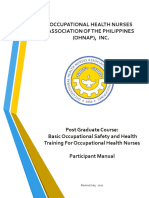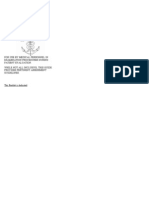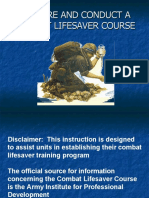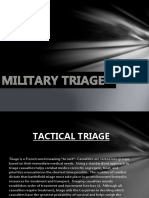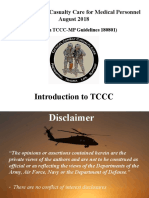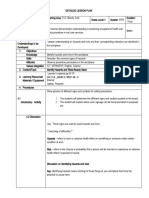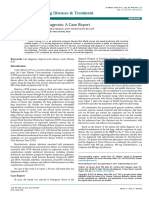Module 03 - Care Under Fire: Speaker Notes
Module 03 - Care Under Fire: Speaker Notes
Uploaded by
Sae TumCopyright:
Available Formats
Module 03 - Care Under Fire: Speaker Notes
Module 03 - Care Under Fire: Speaker Notes
Uploaded by
Sae TumOriginal Title
Copyright
Available Formats
Share this document
Did you find this document useful?
Is this content inappropriate?
Copyright:
Available Formats
Module 03 - Care Under Fire: Speaker Notes
Module 03 - Care Under Fire: Speaker Notes
Uploaded by
Sae TumCopyright:
Available Formats
COMBAT LIFESAVER TACTICAL COMBAT CASUALTY CARE (TCCC)
SPEAKER NOTES
MODULE 03 – CARE UNDER FIRE
SLIDE 1 – TITLE SLIDE
SLIDE 2 – TCCC ROLES
Tactical Combat Casualty Care is broken up into four
roles of care. The most basic is taught to All Service
Members (ASM), which is designed to instruct in the
absolute basics of hemorrhage control and to recognize
more serious injuries.
You are in the Combat Lifesaver (CLS) role.
This teaches you more advanced care to treat the
most common causes of death on the battlefield, and to
recognize, prevent, and communicate with medical
personnel the life-threatening complications of
these injuries.
The Combat Medic/Corpsman (CMC) role includes much more advanced and invasive care requiring
significantly more medical knowledge and skills.
Finally, the last role, Combat Paramedic/Provider (CPP) is for Combat paramedics and advanced
providers, to provide the most sophisticated care to keep our wounded warriors alive and get them to
definitive care.
Your role as a CLS is to treat the most common causes of death on the battlefield, which are massive
hemorrhage and airway/respiratory problems. Also, you are given the skills to prevent complications and
treat other associated but not immediately life-threatening injuries.
TCCC CLS SPEAKER NOTES #TCCC-CLS-14-01 25 JAN 20
COMBAT LIFESAVER TACTICAL COMBAT CASUALTY CARE (TCCC)
SPEAKER NOTES
SLIDE 3 – TLO/ELO
The Care Under Fire (CUF) module has five cognitive
learning objectives and four performance learning
objectives. The cognitive learning objectives are to:
1. Describe the role of fire superiority and threat
containment and the impact of the tactical
environment on Tactical Combat Casualty Care
(TCCC)
2. Describe the actions required before engaging with a casualty to prevent harm or additional
casualties in accordance with CoTCCC guidelines
3. Identify appropriate actions and priorities to treat and move casualties in CUF
4. Identify the importance of early application of limb tourniquets to control life-threatening bleeding
5. Describe the principles, advantages, and disadvantages of one-person drag/carry or two-person
drag/carry in CUF
The four performance learning objectives are to:
1. Demonstrate the one-handed tourniquet application to self in CUF
2. Demonstrate the two-handed tourniquet application to a casualty in CUF
3. Demonstrate the one-person drag/carry of a casualty in CUF
4. Demonstrate the two-person drag/carry of a casualty in CUF
The initial priority of CUF is to return fire, suppress the enemy, and gain fire superiority. Treatment
priorities while still under effective enemy fire/threat are addressing massive hemorrhage with tourniquets
and moving the casualty to cover.
SLIDE 4 – THREE PHASES OF TCCC
CUF is the first of three phases of TCCC. It is the
lifesaving care provided while still under active enemy
fire or threat. Actions are prioritized to suppress enemy
fire, gain fire superiority to prevent further harm or
additional casualties, identify and control life-
threatening bleeding, and move the casualty to cover.
TCCC CLS SPEAKER NOTES #TCCC-CLS-14-01 25 JAN 20
COMBAT LIFESAVER TACTICAL COMBAT CASUALTY CARE (TCCC)
SPEAKER NOTES
SLIDE 5 – PHASE 1: CARE UNDER FIRE
CUF is the care rendered by the first responder/CLS at
the scene of the injury while still under effective hostile
fire. Available medical equipment is limited to that
carried by the individual responder or casualty (Joint
First Aid Kit (JFAK) or a CLS bag). Remember: Always
use the casualty’s JFAK first.
The critical feature of CUF is that the casualty and
responder/CLS are still under effective hostile fire.
The mission does not stop just because there is a casualty. Most battlefield casualty scenarios involve
making medical and tactical decisions rapidly. In the combat environment there is no “time-out” when
casualties occur. Good medicine can sometimes be bad tactics; doing the RIGHT thing at the WRONG
time can get you and your teammates killed or cause the mission to fail.
Remember: Do not become a casualty! Assess the situation and the risk. Suppress enemy fire
and gain fire superiority first. Communicate with and direct the casualty to return fire, move to
cover, apply self-aid, and develop a plan before moving to care for a casualty under fire.
TCCC CLS SPEAKER NOTES #TCCC-CLS-14-01 25 JAN 20
COMBAT LIFESAVER TACTICAL COMBAT CASUALTY CARE (TCCC)
SPEAKER NOTES
SLIDE 6 – ROLE OF FIRE SUPERIORITY
Remember to return fire and take cover. The best
medicine on the battlefield is fire superiority!
SLIDE 7 – FIRE SUPERIORITY
PRINCIPLES
Order of initial actions will be dictated by the tactical
situation.
Little time is available to provide casualty care while
under effective enemy fire. Suppressing hostile fire and
gaining fire superiority should be the priorities to minimize
the risk of injury to other personnel and minimize
additional injury to the casualty while completing the
mission. Personnel may need to assist in returning fire instead of stopping to care for casualties
(this includes the casualty if they are still able to fight). Wounded service members who are exposed to
enemy fire should be directed to continue to return fire, move as quickly as possible to any nearby cover,
and perform self-aid if able.
SLIDE 8 – CASUALTY SELF-AID
If the casualty is responsive and able, the first
responder/CLS should direct the casualty to return fire,
apply self-aid (tourniquet), re-engage, and move to
cover (if possible).
SLIDE 9 – IF CASUALTY IS UNABLE
TO MOVE
If a casualty is responsive but can’t move, a rescue
plan should be devised and executed if tactically
feasible.
Do not put two people at risk if it can be avoided. If
cover is not available or the wounded Service member
cannot move to cover, they should lie flat and
motionless.
TCCC CLS SPEAKER NOTES #TCCC-CLS-14-01 25 JAN 20
COMBAT LIFESAVER TACTICAL COMBAT CASUALTY CARE (TCCC)
SPEAKER NOTES
SLIDE 10 – PHASE 1: CARE UNDER FIRE
If the casualty cannot apply self-aid or move to cover,
devise and execute a rescue plan to reach the
casualty. Apply a tourniquet “high and tight” as quickly
as possible to stop bleeding (within 1 minute, ideally)
and move the casualty to cover. A casualty can bleed
to death in as little as 3 minutes. The faster you apply a
tourniquet, the better the outcome and the less chance
of shock and death.
SLIDE 11 – MASSIVE BLEEDING IN CARE UNDER FIRE
Remember: If you can do only ONE thing for the
casualty, it should be to identify and stop life-
threatening bleeding, and keep them from bleeding
to death.
SLIDE 12 – CARE UNDER FIRE
OVERVIEW – BLEEDING CONTROL
(VIDEO)
Play video.
SLIDE 13 – IDENTIFY LIFE-
THREATENING BLEEDING
The following are examples of when bleeding is
considered life-threatening: 1) there is a traumatic
amputation of an arm or leg; 2) there is pulsing or
steady bleeding from the wound; 3) blood is pooling on
the ground; 4) the overlying clothes are soaked with
blood; 5) bandages or makeshift bandages used to
cover the wound are ineffective and are steadily
TCCC CLS SPEAKER NOTES #TCCC-CLS-14-01 25 JAN 20
COMBAT LIFESAVER TACTICAL COMBAT CASUALTY CARE (TCCC)
SPEAKER NOTES
becoming soaked with blood; 6) there was prior bleeding, and the patient is now in shock (unconscious,
confused, pale). If you see any of these examples, it means that a tourniquet is needed to stop life-
threatening bleeding.
You may not really know if hemorrhage is life-threatening until the Tactical Field Care phase when the
wound can be exposed and evaluated. If a life-threatening hemorrhage is suspected, you should treat it
immediately.
Remember during CUF the only medical intervention is applying a tourniquet to stop life-threatening
bleeding from an extremity injury. Other wounds (neck, armpit, groin, or abdomen) are not treated during
CUF. If the casualty is able, direct them to apply pressure to the wounds as self-aid. Airway and other
issues are also not treated until the TFC phase.
Notes about the tourniquet:
• Constricting band placed around an arm or leg to stop bleeding
• Typically, 2 inches wide
o Width reduces tissue damage
• Quick to apply and can stop life-threatening extremity bleeding
• High and tight during CUF
• 2–3 inches above the wound during TFC
• Do not document the tourniquet time during CUF; document during TFC
SLIDE 14 – TIME TO BLEED OUT
The number one medical priority in CUF is early
control of severe bleeding. Extremity hemorrhage is
the most frequent cause of preventable battlefield
deaths. Over 2,500 deaths occurred in Vietnam
secondary to hemorrhage from extremity wounds. A
large number of deaths in Iraq and Afghanistan were
also seen from hemorrhage. Injury to a major vessel
can quickly lead to shock and death. Only life-threatening bleeding warrants intervention during Care
Under Fire. Casualties with injuries to large central blood vessels (like the femoral artery in the groin, the
axillary artery in the arm, or the carotid artery in the neck) can bleed to death in as little as 3 minutes.
Play video of Care Under Fire Bleeding Video.
SLIDE 15 – KNOW YOUR ACCESS TO
A TOURNIQUET
All personnel on combat missions should have a
CoTCCC-recommended tourniquet readily available
(standard location on their battle gear) and be trained
in its use. Casualties should be able to easily and
quickly reach and apply their own tourniquet.
Tourniquets should NEVER be at the bottom of the
pack. Always use the casualty’s tourniquet (JFAK) first.
TCCC CLS SPEAKER NOTES #TCCC-CLS-14-01 25 JAN 20
COMBAT LIFESAVER TACTICAL COMBAT CASUALTY CARE (TCCC)
SPEAKER NOTES
SLIDE 16 – ONE-HANDED TOURNIQUET
SELF-APPLICATION
Casualty may need to apply one-handed tourniquet
to an upper extremity when applying self-aid. One-
handed tourniquets are used to apply self-aid for
bleeding from an injury to the upper arm or forearm.
SLIDE 17 – ONE-HANDED WINDLASS
TOURNIQUET APPLICATION (VIDEO)
Play the video.
SLIDE 18 – ONE-HANDED RATCHET
TOURNIQUET APPLICATION (VIDEO)
Play the video.
SLIDE 19 – ONE-HANDED TOURNIQUET
APPLICATION CRITICAL POINTS
All personnel on combat missions should have a
CoTCCC-recommended tourniquet readily available
(standard location on their battle gear) and be trained
in its use. Casualties should be able to easily and
quickly reach and apply their own tourniquet.
TCCC CLS SPEAKER NOTES #TCCC-CLS-14-01 25 JAN 20
COMBAT LIFESAVER TACTICAL COMBAT CASUALTY CARE (TCCC)
SPEAKER NOTES
SLIDE 20 – BUDDY AID IF CASUALTY IS
UNRESPONSIVE OR UNABLE TO MOVE
If a casualty is unresponsive and/or unable move, a
rescue plan should be devised and executed if
tactically feasible. Do not put two people at risk if it can
be avoided. If cover is not available or the wounded
Service member cannot move to cover, they should lie
flat and motionless. Quickly perform a blood sweep
(looking for major bleeding). Apply a hasty tourniquet
high and tight on the injured extremity and get to cover as quickly as possible. Be sure to use equipment
(tourniquet) in the casualty’s JFAK and not your own. Do not put a tourniquet directly over the knee or
elbow or over a holster or cargo pocket that contains bulky items.
SLIDE 21 – TWO-HANDED RATCHET TOURNIQUET APPLICATION (VIDEO)
Play the video.
SLIDE 22 – TWO-HANDED (WINDLASS)
TOURNIQUET APPLICATION (VIDEO)
Play the video.
TCCC CLS SPEAKER NOTES #TCCC-CLS-14-01 25 JAN 20
COMBAT LIFESAVER TACTICAL COMBAT CASUALTY CARE (TCCC)
SPEAKER NOTES
SLIDE 23 – SKILL STATION
At this time we will break into skill stations to practice
the following skills:
• One-Handed (Windlass) TQ Application in CUF
• One-Handed (Ratchet) TQ Application in CUF
• Two-Handed (Ratchet) TQ Application in CUF
• Two-Handed (Windlass) TQ Application in CUF
SLIDE 24 – EXTRACTION OF
CASUALTIES
Follow unit standard operating procedures for
removing/extracting casualties from vehicles.
If the casualty is on fire, put out the fire, address life-
threatening bleeding with a tourniquet if indicated, and
move to cover as quickly as possible.
SLIDE 25 – CRITICAL OBJECTIVES
FOR THE ONE- OR TWO-PERSON
DRAG/CARRY
Remember: Once a tourniquet has been applied, the
priority is to get the casualty to the nearest cover and
out of effective enemy fire/threat.
Carries and drags will enable the first responder/CLS
to do this as quickly as possible without causing
further harm to the casualty.
SLIDE 26 – ONE-PERSON DRAG/CARRY
A variety of effective carries can be used depending on
the casualty’s level of consciousness, enemy threat level,
terrain, etc.
Here are some examples of the one-person drag/carry:
support carry (for a conscious casualty), neck drag (helps
limit exposure from enemy fire based on low crawl of
rescuer), kit/arm drag (rescuer pulls casualty backwards
to safety), and cradle-drop, which allows rescuer to move
the casualty short distances.
TCCC CLS SPEAKER NOTES #TCCC-CLS-14-01 25 JAN 20
COMBAT LIFESAVER TACTICAL COMBAT CASUALTY CARE (TCCC)
SPEAKER NOTES
SLIDE 27 – ONE-PERSON CASUALTY
DRAG/CARRY (VIDEO)
Play the video.
SLIDE 28 – TWO-PERSON DRAG/CARRY
A variety of effective carries can be used, depending on
the casualty’s level of consciousness, enemy threat
level, terrain, etc.
Some examples of the two-person drag/carry include:
two-man supporting carry (casualty is carried between
two rescuers), kit/arm (two rescuers drag the casualty
by their drag handle), and fore/aft (casualty is carried
between two rescuers moving forward in unison).
SLIDE 29 – TWO-PERSON
DRAG/CARRY (VIDEO)
Play the video.
SLIDE 30 – SKILL STATION
At this time, we will break into skill stations to practice
the following skills:
• One-Person Drag/Carry
• Two-Person Drag/Carry
TCCC CLS SPEAKER NOTES #TCCC-CLS-14-01 25 JAN 20
COMBAT LIFESAVER TACTICAL COMBAT CASUALTY CARE (TCCC)
SPEAKER NOTES
SLIDE 31 – SUMMARY
Care Under Fire is the care rendered by the first
responder/CLS at the scene of the injury while still
under effective hostile fire.
Remember to return fire and take cover. The best
medicine on the battlefield is fire superiority!
If you can do only ONE thing for the casualty, identify
and stop life-threatening bleeding, and keep them from
bleeding to death by using a CoTCCC-recommended
tourniquet.
Once a tourniquet has been applied, the priority is to get the casualty to the nearest cover and out of
effective enemy fire/threat.
Drag/carry will enable the first responder/CLS to do this as quickly as possible without causing further
harm to the casualty.
SLIDE 32 – CHECK ON LEARNING
Ask questions of the learners, referring to key concepts from the module.
Now for a check on learning.
1) What is Care Under Fire?
- Care Under Fire is the care given by the first
responder at the scene of the injury while they
and the casualty are still under effective
hostile fire or near the threat. Available
medical equipment is limited to that carried in
the individual Service member’s JFAK.
2) What are the signs of life-threatening bleeding?
- Bright red blood is pooling on the ground
- The overlying clothes are soaked with blood
- There is a traumatic AMPUTATION of an arm or leg
- There is pulsatile (pulsing) or steady bleeding from the wound
3) How long does it take to bleed to death from a complete femoral artery and vein disruption?
- 3 minutes
4) What are the advantages and disadvantages of a one-person drag?
- Advantages: No equipment required and only one rescuer is exposed to enemy fire.
- Disadvantages: Relatively slow to move the casualty; does not allow optimal body position for
dragging the casualty; can be tiring for the first responder if the patient is heavy or wearing a lot
of gear.
5) What are the advantages and disadvantages of a two-person carry?
- Advantages: May be useful in situations where drags do not work well; less painful for the
casualty than dragging; quicker than most one-person carries.
- Disadvantages: Causes the rescuers to have a higher silhouette than most drags, exposing
them to possible hostile fire; hard to accomplish with the rescuer’s and/or the casualty’s
equipment being worn.
TCCC CLS SPEAKER NOTES #TCCC-CLS-14-01 25 JAN 20
COMBAT LIFESAVER TACTICAL COMBAT CASUALTY CARE (TCCC)
SPEAKER NOTES
SLIDE 33 – QUESTIONS
TCCC CLS SPEAKER NOTES #TCCC-CLS-14-01 25 JAN 20
You might also like
- Magadran FMT BookDocument32 pagesMagadran FMT Bookkalyan100% (7)
- OHNAP Online BOSH Manual (As of September 2021)Document276 pagesOHNAP Online BOSH Manual (As of September 2021)cuisonhospinc100% (1)
- Medical Assessment - Ukrainian World Congress. July 28th - August 8th, 2014Document53 pagesMedical Assessment - Ukrainian World Congress. July 28th - August 8th, 2014Patrick ChellewNo ratings yet
- TCCC Skill Sets by Responder Level Master 190422 ApprovedDocument4 pagesTCCC Skill Sets by Responder Level Master 190422 ApprovedIon MarinNo ratings yet
- Military Classes of Supply PDFDocument2 pagesMilitary Classes of Supply PDFCisko MadouNo ratings yet
- Aeromedical Evacuation ProceduresDocument19 pagesAeromedical Evacuation ProcedurescdogbricksquadNo ratings yet
- Module 04 - Principles and Application of TFC: Speaker NotesDocument7 pagesModule 04 - Principles and Application of TFC: Speaker NotesSae Tum100% (1)
- Effect of Vitamin D Supplementation On Testosterone Levels in MenDocument4 pagesEffect of Vitamin D Supplementation On Testosterone Levels in MenMuhammad UmerNo ratings yet
- Instructor Guide For Introduction To TCCC-MP 180801Document16 pagesInstructor Guide For Introduction To TCCC-MP 180801M. Owen ErwinNo ratings yet
- 010303A TCCC-MP Tactical Field Care #1 IG 160603Document43 pages010303A TCCC-MP Tactical Field Care #1 IG 160603herralainNo ratings yet
- Tactical First Aid 0410+Document265 pagesTactical First Aid 0410+Carlos SanzNo ratings yet
- Trauma-Focused Individual Training: Revised and Updated January 2005Document101 pagesTrauma-Focused Individual Training: Revised and Updated January 2005Mark Cheney100% (3)
- A Simple Guide For Combat MedicsDocument29 pagesA Simple Guide For Combat MedicsTheop AyodeleNo ratings yet
- 6 Overview of Navy Medicine PDFDocument16 pages6 Overview of Navy Medicine PDFAnisah RahmaNo ratings yet
- 8 TCCC Scenarios IgDocument35 pages8 TCCC Scenarios Igherbert rogan0% (1)
- Tactical Combat Casualty Care February 2009Document39 pagesTactical Combat Casualty Care February 2009beerensd100% (1)
- Navy Medical AssessementDocument36 pagesNavy Medical AssessementstreetdoccanedoNo ratings yet
- Medical ATO Report: Ukraine Rapid Communique: " 100 Meters " Winter 2016-2017Document65 pagesMedical ATO Report: Ukraine Rapid Communique: " 100 Meters " Winter 2016-2017Patrick ChellewNo ratings yet
- Prepare and Conduct A Combat Lifesaver CourseDocument48 pagesPrepare and Conduct A Combat Lifesaver CourseJonathan Menchaca100% (2)
- 09u NAEMT News Winter 2010 PHTLS TCCC ArticleDocument2 pages09u NAEMT News Winter 2010 PHTLS TCCC ArticleBrandon Draven100% (1)
- 010303B TCCC-MP Tactical Field Care #2 IG 160603Document45 pages010303B TCCC-MP Tactical Field Care #2 IG 160603herralainNo ratings yet
- Glossary of Military AcronymsDocument8 pagesGlossary of Military AcronymsGordana Kubura100% (1)
- 8 TCCC ScenariosDocument109 pages8 TCCC ScenariosKassu KanaNo ratings yet
- Introduction To TCCC: Tactical Combat Casualty Care For All Combatants August 2017Document36 pagesIntroduction To TCCC: Tactical Combat Casualty Care For All Combatants August 2017INSTRUCTOR INTERNACIONAL ANTONIO RAMIREZNo ratings yet
- Military TriageDocument23 pagesMilitary TriageKai CalbesNo ratings yet
- Army Life - Your Guide To The Medical ServicesDocument15 pagesArmy Life - Your Guide To The Medical Servicesdemarchi2330No ratings yet
- Mountain Warrior November 09Document24 pagesMountain Warrior November 094thBrigade4thInfantryDivisionNo ratings yet
- Leading Causes of DeathDocument1 pageLeading Causes of DeathmackNo ratings yet
- Military Triage and Evacuation: Parallels To Civilian SystemsDocument28 pagesMilitary Triage and Evacuation: Parallels To Civilian SystemsNuniek SetyoriniNo ratings yet
- Basic Life SupportDocument1 pageBasic Life SupportAminath MeesanNo ratings yet
- jp4 02ch1Document314 pagesjp4 02ch1Dave91No ratings yet
- FLWG Encampment Guide (2010)Document11 pagesFLWG Encampment Guide (2010)CAP History LibraryNo ratings yet
- US Army TOE 31807L000 Special Forces Company Special Forces BattalionDocument2 pagesUS Army TOE 31807L000 Special Forces Company Special Forces Battalionfoxbat05No ratings yet
- 06 SepDocument32 pages06 SeprbfpdNo ratings yet
- Charities in UkraineDocument4 pagesCharities in UkraineElliot Vadi OzolinsNo ratings yet
- HM - Navedtra 14295b, Corpsman Manual, Medical RecordsDocument38 pagesHM - Navedtra 14295b, Corpsman Manual, Medical RecordsLueshen WellingtonNo ratings yet
- Navy Irregular Warfare and Counterterrorism Operations: Background and Issues For CongressDocument25 pagesNavy Irregular Warfare and Counterterrorism Operations: Background and Issues For Congressacasonot6618No ratings yet
- 3 Tactical Field CareDocument164 pages3 Tactical Field CareINSTRUCTOR INTERNACIONAL ANTONIO RAMIREZ100% (1)
- US Navy SEALs Rank Structure, Insignia, and Pay (Updated 2022)Document1 pageUS Navy SEALs Rank Structure, Insignia, and Pay (Updated 2022)oloveder.2509No ratings yet
- Management of Trauma PatientsDocument10 pagesManagement of Trauma PatientsShennie C AnteNo ratings yet
- Point of Wounding Care 1Document53 pagesPoint of Wounding Care 1srtmedicNo ratings yet
- BATLSDocument70 pagesBATLSVitor Hugo G CorreiaNo ratings yet
- Module 4 TFC TC3 CLSDocument51 pagesModule 4 TFC TC3 CLSLee SmithNo ratings yet
- (Training) United States Army FM 7-21.13 - 15 October 2003Document420 pages(Training) United States Army FM 7-21.13 - 15 October 2003Leo HermosilloNo ratings yet
- CQB Level 1 2016 - GermanyDocument12 pagesCQB Level 1 2016 - GermanyEmre ÖDER100% (1)
- Example of A Swat Medic ProposalDocument8 pagesExample of A Swat Medic ProposalTakeshiShinoharaNo ratings yet
- Force Health ProtectionDocument71 pagesForce Health ProtectionJared A. Lang100% (1)
- Annex S-App 9 Religious SupportDocument9 pagesAnnex S-App 9 Religious SupportwlamillerNo ratings yet
- S Pre-Hospitalcaresystems BrochureDocument28 pagesS Pre-Hospitalcaresystems Brochureadmin adminNo ratings yet
- The Mobile Army Surgical Hospital (MASH) A Military and Surgical LegacyDocument9 pagesThe Mobile Army Surgical Hospital (MASH) A Military and Surgical LegacyHowardNo ratings yet
- Tactical Combat Casualty Care (TCCC) Card: Battle Roster #: Urgent Priority Routine EvacDocument2 pagesTactical Combat Casualty Care (TCCC) Card: Battle Roster #: Urgent Priority Routine EvacrubenNo ratings yet
- MCRP 3-0B How To Conduct TrainingDocument134 pagesMCRP 3-0B How To Conduct Trainingdelpap1No ratings yet
- Intimidate Foe Rally Comrades Protect Companion KnockbackDocument1 pageIntimidate Foe Rally Comrades Protect Companion KnockbackDavid SeraciniNo ratings yet
- Philippine TCCC Course ManualDocument89 pagesPhilippine TCCC Course Manualdiosmadelmark11100% (1)
- Military Nurses in VietnamDocument3 pagesMilitary Nurses in VietnamChildren Of Vietnam Veterans Health Alliance100% (2)
- Ambulance Vehicle Operator: Driver Behavior and Performance Checklist (D1)Document25 pagesAmbulance Vehicle Operator: Driver Behavior and Performance Checklist (D1)Ronald AranhaNo ratings yet
- 1 Introduction To TCCC USA 20015Document47 pages1 Introduction To TCCC USA 20015Jorge Almeida Costa100% (1)
- The Tactical Combat Casualty Care Casualty Card - TCCC Guidelines - Proposed Change 1301Document9 pagesThe Tactical Combat Casualty Care Casualty Card - TCCC Guidelines - Proposed Change 1301Paschalis Devranis100% (1)
- Combat Medic - Wikipedia, The Free Encyclopedia PDFDocument5 pagesCombat Medic - Wikipedia, The Free Encyclopedia PDFGrant SmithNo ratings yet
- TCCC Speaker NotesDocument10 pagesTCCC Speaker NotesVitorNo ratings yet
- Module 9 SNDocument9 pagesModule 9 SNchingiman2.0No ratings yet
- Module 14 - Analgesia and Antibiotic Administration: Speaker NotesDocument5 pagesModule 14 - Analgesia and Antibiotic Administration: Speaker NotesSae TumNo ratings yet
- Asm Course Speaker NotesDocument15 pagesAsm Course Speaker NotesJesse RobertNo ratings yet
- Principles and Application of Tactical Field Care (TFC) : Skill InstructionsDocument3 pagesPrinciples and Application of Tactical Field Care (TFC) : Skill InstructionsSae TumNo ratings yet
- Principles and Application of Tactical Field Care (TFC) : Skill InstructionsDocument3 pagesPrinciples and Application of Tactical Field Care (TFC) : Skill InstructionsSae TumNo ratings yet
- Skills Assessment Checklist: MODULE 14: Pain Medication and Antibiotic AdministrationDocument2 pagesSkills Assessment Checklist: MODULE 14: Pain Medication and Antibiotic AdministrationSae TumNo ratings yet
- One-Person Bag Valve Mask (BVM) : MarchDocument1 pageOne-Person Bag Valve Mask (BVM) : MarchSae TumNo ratings yet
- Head-Tilt/Chin-Lift: DO NOT Use If A Spinal or Neck Injury Is SuspectedDocument1 pageHead-Tilt/Chin-Lift: DO NOT Use If A Spinal or Neck Injury Is SuspectedSae TumNo ratings yet
- Analgesia Administration/ Antibiotic Admin: Skill InstructionsDocument3 pagesAnalgesia Administration/ Antibiotic Admin: Skill InstructionsSae TumNo ratings yet
- Atbf PDFDocument1 pageAtbf PDFSae TumNo ratings yet
- One-Handed (Ratchet) Tourniquet Application: Care Under Fire (Cuf)Document1 pageOne-Handed (Ratchet) Tourniquet Application: Care Under Fire (Cuf)Sae TumNo ratings yet
- Two-Person Drag/Carry: Kit or Arm DragDocument3 pagesTwo-Person Drag/Carry: Kit or Arm DragSae TumNo ratings yet
- Atbf Ista PDFDocument12 pagesAtbf Ista PDFSae TumNo ratings yet
- Skills Assessment Checklist: MODULE 11: Hypothermia PreventionDocument2 pagesSkills Assessment Checklist: MODULE 11: Hypothermia PreventionSae TumNo ratings yet
- Skills Assessment Checklist: MODULE 19: Pre-Evacuation Procedures, Communication, and DocumentationDocument3 pagesSkills Assessment Checklist: MODULE 19: Pre-Evacuation Procedures, Communication, and DocumentationSae TumNo ratings yet
- One-Person Drag/Carry: Kit or Arm DragDocument5 pagesOne-Person Drag/Carry: Kit or Arm DragSae TumNo ratings yet
- Evacuation Procedures: Skill InstructionsDocument3 pagesEvacuation Procedures: Skill InstructionsSae TumNo ratings yet
- Skills Assessment Checklist: MODULE 6: Massive Hemorrhage Control in TFCDocument7 pagesSkills Assessment Checklist: MODULE 6: Massive Hemorrhage Control in TFCSae TumNo ratings yet
- Skills Assessment Checklist: MODULE 4: Principles and Application of Tactical Field CareDocument1 pageSkills Assessment Checklist: MODULE 4: Principles and Application of Tactical Field CareSae TumNo ratings yet
- Skills Assessment Checklist: MODULE 7: Airway ManagementDocument6 pagesSkills Assessment Checklist: MODULE 7: Airway ManagementSae TumNo ratings yet
- Skills Assessment Checklist: MODULE 11: Hypothermia PreventionDocument2 pagesSkills Assessment Checklist: MODULE 11: Hypothermia PreventionSae TumNo ratings yet
- Two-Handed (Ratchet) Tourniquet Application: Care Under Fire (Cuf)Document1 pageTwo-Handed (Ratchet) Tourniquet Application: Care Under Fire (Cuf)Sae TumNo ratings yet
- Massive Hemorrhage Control in TFC: Skill InstructionsDocument8 pagesMassive Hemorrhage Control in TFC: Skill InstructionsSae TumNo ratings yet
- Module 13 - Eye Injuries: Speaker NotesDocument5 pagesModule 13 - Eye Injuries: Speaker NotesSae TumNo ratings yet
- Airway Management in TFC: Skill InstructionsDocument8 pagesAirway Management in TFC: Skill InstructionsSae TumNo ratings yet
- Principles and Application of Tactical Field Care (TFC) : TCCC Tier 4 TCCC Tier 1 TCCC Tier 3Document17 pagesPrinciples and Application of Tactical Field Care (TFC) : TCCC Tier 4 TCCC Tier 1 TCCC Tier 3Sae Tum0% (1)
- Module 11 - Hypothermia Prevention: Speaker NotesDocument6 pagesModule 11 - Hypothermia Prevention: Speaker NotesSae TumNo ratings yet
- Principles and Application of Tactical Field Care (TFC) : TCCC Tier 4 TCCC Tier 1 TCCC Tier 3Document17 pagesPrinciples and Application of Tactical Field Care (TFC) : TCCC Tier 4 TCCC Tier 1 TCCC Tier 3Sae Tum100% (1)
- Eye Injuries: Skill InstructionsDocument3 pagesEye Injuries: Skill InstructionsSae TumNo ratings yet
- Massive Hemorrhage Control in TFC: Skill InstructionsDocument8 pagesMassive Hemorrhage Control in TFC: Skill InstructionsSae TumNo ratings yet
- Module 07 - Airway Management in TFC: Speaker NotesDocument7 pagesModule 07 - Airway Management in TFC: Speaker NotesSae TumNo ratings yet
- Module 08 - Respiration Assessment and Management in TFC: Speaker NotesDocument8 pagesModule 08 - Respiration Assessment and Management in TFC: Speaker NotesSae TumNo ratings yet
- Basi, Pauline R. NDA-1 March 18, 2020: Function of BandagingDocument9 pagesBasi, Pauline R. NDA-1 March 18, 2020: Function of BandagingPau-pau BasiNo ratings yet
- Inertia Lab Form Edits and Pricing PDFDocument2 pagesInertia Lab Form Edits and Pricing PDFGessa ANo ratings yet
- Biology Project On Effect of Antibiotics On MicroorganismsDocument13 pagesBiology Project On Effect of Antibiotics On Microorganismsitznush15No ratings yet
- Fluor DR Hans C MoolenburghDocument6 pagesFluor DR Hans C MoolenburghJacek KosakowskiNo ratings yet
- Lima Physica Zuk AMFCONNES Product CatalogueDocument56 pagesLima Physica Zuk AMFCONNES Product CatalogueruiduartNo ratings yet
- Instant Access to Child and adolescent psychiatry a developmental approach 4. ed Edition Graham ebook Full ChaptersDocument81 pagesInstant Access to Child and adolescent psychiatry a developmental approach 4. ed Edition Graham ebook Full Chaptersnouliradet100% (2)
- Drop OutsDocument20 pagesDrop Outsrodulfo capangpanganNo ratings yet
- St. Luke'S Medical Center: Case ReportDocument6 pagesSt. Luke'S Medical Center: Case ReportMazin Al-TahirNo ratings yet
- DR Arun Raj GR. Long CVDocument35 pagesDR Arun Raj GR. Long CVArun RajNo ratings yet
- PPT.2021.IPC Best Practices - Doh Report.Document38 pagesPPT.2021.IPC Best Practices - Doh Report.Lucky OlvisNo ratings yet
- POST TEST - NEURO - MR. TOMBOC (SC).docxDocument2 pagesPOST TEST - NEURO - MR. TOMBOC (SC).docxNARDO XXINo ratings yet
- Detailed Lesson Plan in Nailcare - 8Document3 pagesDetailed Lesson Plan in Nailcare - 8Frankie Snook Bravo IIINo ratings yet
- Instant download Advances in the Neurochemistry and Neuropharmacology of Tourette Syndrome 1st Edition Davide Martino And Andrea E. Cavanna (Eds.) pdf all chapterDocument81 pagesInstant download Advances in the Neurochemistry and Neuropharmacology of Tourette Syndrome 1st Edition Davide Martino And Andrea E. Cavanna (Eds.) pdf all chaptersiddhcoons1o100% (4)
- Drug Enforcement Vice Control and Organized Week 5Document37 pagesDrug Enforcement Vice Control and Organized Week 5Enzo MacTavish SendohNo ratings yet
- Discharge PlanDocument4 pagesDischarge PlanMaythresha GonzalesNo ratings yet
- 86 Questions.Document27 pages86 Questions.Ibrahim100% (9)
- Update On Diabetes Treatment - 2018Document33 pagesUpdate On Diabetes Treatment - 2018Nanda SalmasNo ratings yet
- Atrial Septal Defect With Pulmonary Hypertension: When/how Can We Consider Closure?Document9 pagesAtrial Septal Defect With Pulmonary Hypertension: When/how Can We Consider Closure?Faradiba MaricarNo ratings yet
- Assessment of Endocrine System: History TakingDocument14 pagesAssessment of Endocrine System: History TakingNida Naaz100% (2)
- Polyganglionitis Episodica (PGE) : The New Concept For Viral Polyganglionitis of The Head and NeckDocument25 pagesPolyganglionitis Episodica (PGE) : The New Concept For Viral Polyganglionitis of The Head and Neck0007 AndrezaNo ratings yet
- Donning and Removing Sterile GlovesDocument19 pagesDonning and Removing Sterile GlovesWilma Beralde100% (1)
- Signs of Urethral TraumaDocument6 pagesSigns of Urethral TraumaWenna Grace OdtujanNo ratings yet
- Pizotifen MalateDocument2 pagesPizotifen MalatesadafNo ratings yet
- SFL Joining KitDocument11 pagesSFL Joining Kitdharam singhNo ratings yet
- K 29 Sirkulasi Koroner - CVS K29Document16 pagesK 29 Sirkulasi Koroner - CVS K29Jane Andrea Christiano DjianzonieNo ratings yet
- Cystic Fibrosis Late Diagnosis A Case ReportDocument3 pagesCystic Fibrosis Late Diagnosis A Case ReportVivi DeviyanaNo ratings yet
- Icu AwDocument40 pagesIcu AwSiriporn PongpattarapakNo ratings yet

